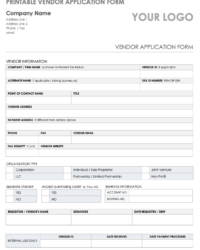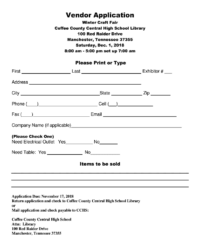Utilizing a structured form streamlines vendor selection, ensuring organizers have consistent information for all applicants. This simplifies comparison, promotes fairness, and facilitates efficient decision-making. For artisans, a predefined structure clarifies expectations, reduces the risk of omitting crucial information, and presents a professional image. Ultimately, this structured approach contributes to a well-organized event with a diverse and high-quality selection of crafts.
The following sections will delve into the specific components typically found within these applications, offer guidance on completing them effectively, and provide examples of best practices for crafting a compelling submission.
Key Components of a Craft Show Application
Applications for craft show participation typically request specific information to evaluate applicants effectively and ensure a well-organized event. Understanding these key components is crucial for a successful application.
1. Contact Information: This section requires accurate and up-to-date contact details, including name, business name (if applicable), email address, phone number, and mailing address. Clear contact information is essential for communication regarding acceptance, booth assignments, and other logistical details.
2. Craft Description: A concise and compelling description of the crafts offered is essential. This should outline the types of items created, materials used, and the unique aspects of the work. Clear, high-quality images of representative crafts are often required.
3. Booth Information: Applicants typically specify their booth setup requirements, including size, electricity needs, and display preferences. Providing accurate information helps organizers plan the event layout and ensure adequate space and resources for each vendor.
4. Business Details: Applications may request information about the applicant’s business structure (e.g., sole proprietorship, LLC), sales tax permit number, and insurance details. This information ensures compliance with legal and regulatory requirements.
5. Show Experience: Listing previous craft show participation demonstrates experience and professionalism. Including the names and dates of past events can strengthen an application.
6. Website and Social Media: Providing links to a website or social media presence allows organizers to further evaluate an applicant’s work and reach. This also provides potential customers with additional avenues to explore the artisan’s offerings.
7. Application Fee: Information about the application fee, including the amount and payment methods, is usually included. Applicants should be prepared to submit the fee along with their completed application.
Providing complete and accurate information in each of these areas increases the likelihood of a successful application and contributes to a smooth and efficient event planning process for all involved. Thorough preparation reflects professionalism and demonstrates a commitment to participating in the craft show.
How to Create a Craft Show Application Template
Developing a standardized application template streamlines vendor selection for craft shows, ensuring consistent data collection and facilitating efficient evaluation. This structured approach benefits both organizers and applicants by clarifying expectations and promoting a professional process.
1. Define Essential Information: Determine the crucial data points needed from applicants. This typically includes contact information, craft descriptions, booth requirements, business details, show experience, online presence, and application fee information. Consider the specific needs of the event when defining these requirements.
2. Structure the Template: Organize the information into clear and logical sections. Use headings and subheadings to guide applicants through the form and ensure all necessary information is provided.
3. Provide Clear Instructions: Include concise and unambiguous instructions for each section. Specify required formats, character limits, and any specific details needed for accurate completion.
4. Incorporate Visual Elements: Utilize visual elements such as clear formatting, spacing, and font choices to enhance readability and create a professional appearance. Consider incorporating the event logo or branding.
5. Offer Multiple Formats: Make the template available in various formats (e.g., downloadable PDF, online form) to accommodate different applicant preferences and ensure accessibility.
6. Test and Refine: Before distributing the template, thoroughly test it to identify any ambiguities or areas for improvement. Solicit feedback from potential applicants to refine the design and ensure clarity.
7. Distribute and Promote: Make the application easily accessible through the event website, social media channels, and email communications. Clearly communicate application deadlines and procedures.
8. Maintain and Update: Regularly review and update the template to reflect evolving event needs and incorporate feedback from organizers and applicants. Keeping the template current ensures continued effectiveness.
A well-designed application template fosters a professional and organized approach to vendor selection. It ensures consistency, simplifies evaluation, and ultimately contributes to a successful craft show experience for both organizers and participants.
Standardized application forms serve as valuable tools for managing vendor participation in craft shows. These templates ensure consistent data collection, streamline the evaluation process, and promote fairness and transparency. Careful consideration of key components, clear instructions, and accessible formats contribute to a more efficient and professional experience for both organizers and applicants. A well-designed template facilitates effective communication and contributes to a smoother event planning process overall.
Effective vendor management is crucial for a successful craft show. Utilizing a well-structured application process fosters a positive experience for all participants and contributes to the overall quality and organization of the event. By embracing standardized procedures, craft show organizers can create a more efficient, equitable, and enjoyable environment for vendors and attendees alike.


